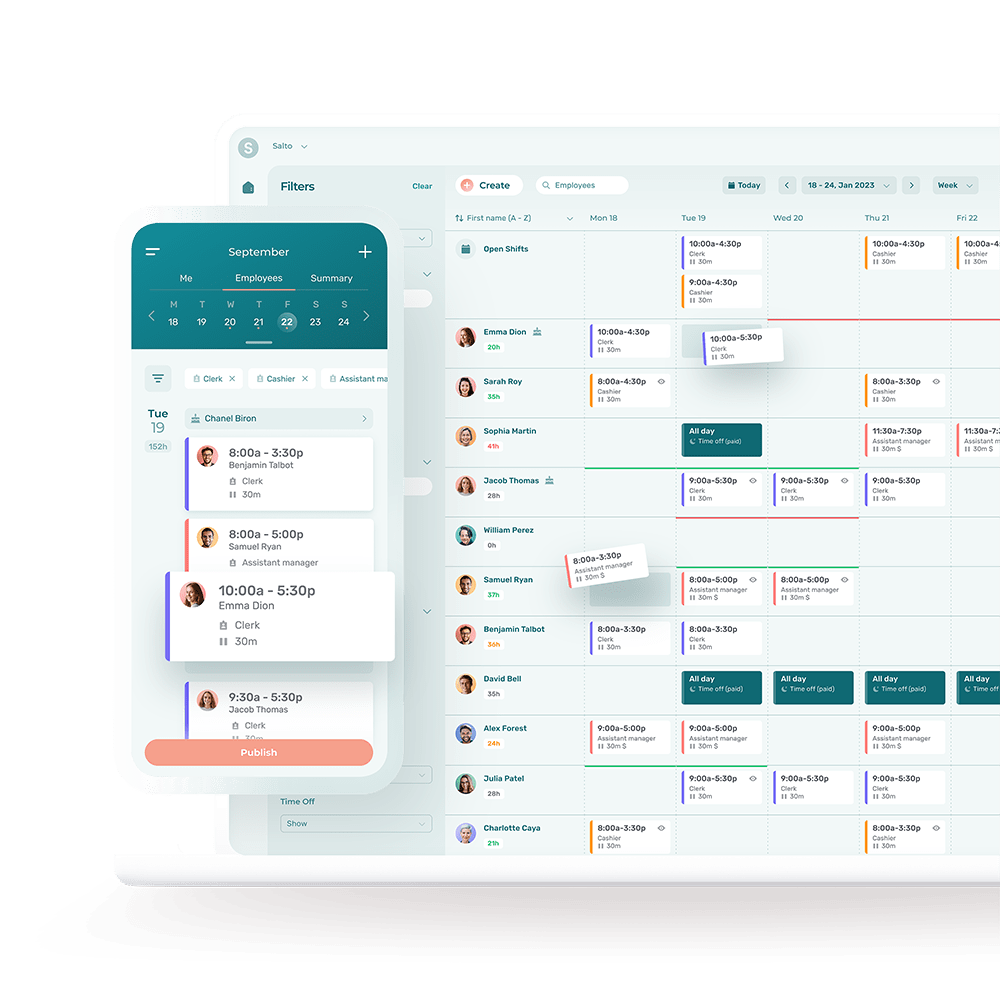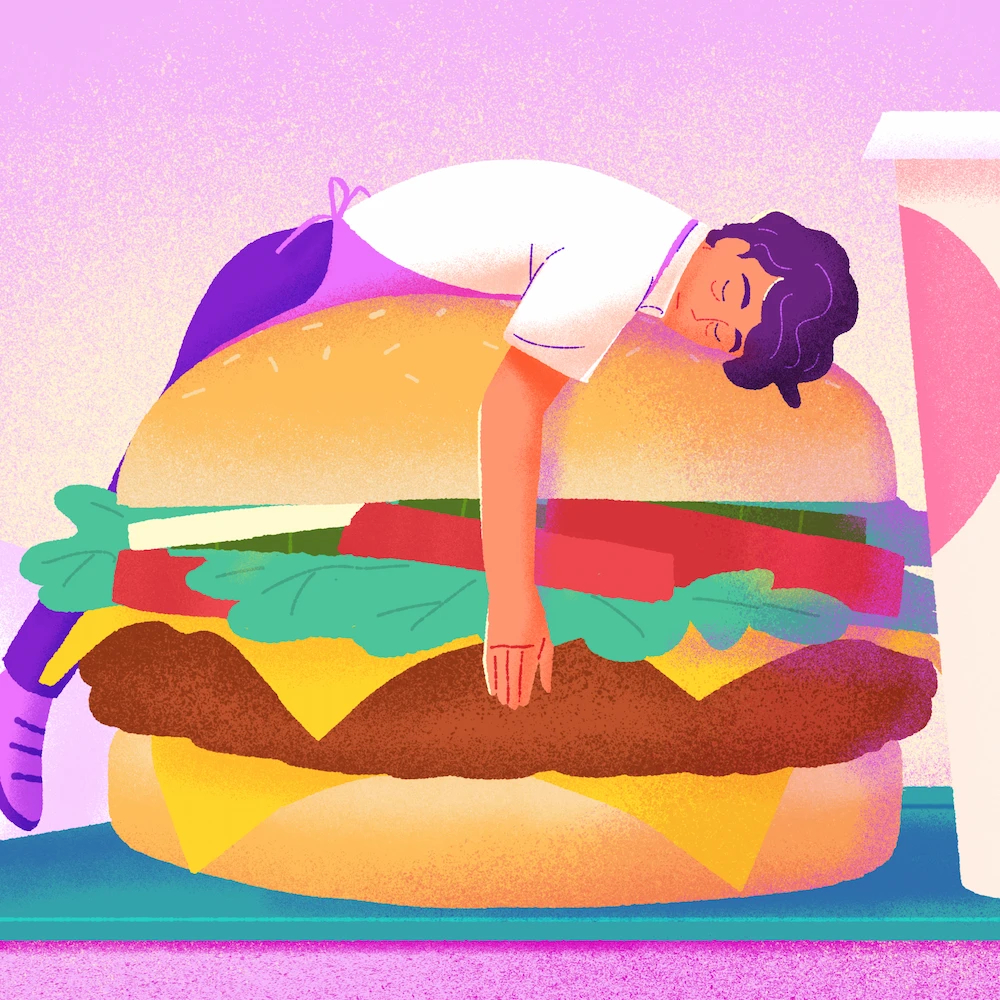Seniors’ residences need a multidisciplinary team to ensure the quality of their services and the well-being of their residents.
The positions to be filled can therefore vary a lot, depending on the services offered by your nursing home. Residences also face significant recruitment and retention challenges because of their atypical working hours.
It is therefore essential for seniors’ residence managers to optimize their workforce—and compensate for absenteeism—thanks to a deep understanding of the various positions within their organization. This includes the tasks to be performed by each employee.
In this article, you will learn:
- The roles of the various employees in a seniors’ residence
- Job description for a care attendant
- Job description for a nurse
- Job description for a receptionist
- Job description for a food service attendant
- The importance of work-life balance for seniors’ residence staff
The Various Roles in a Seniors’ Residence
A seniors’ residence is a living environment that provides an appealing lifestyle for residents, all while offering health care services to meet their diverse needs. The variety of roles to be filled in order to provide the various services is therefore vast.
Residences are open 24 hours a day, 365 days a year, which requires a great deal of staff and flexibility to ensure quality service at all times.
Some employees may be trained for multiple positions, such as receptionist and maintenance worker, while others may be specialized in their field, such as nurse or beneficiary attendant. Some employees have employment contracts governed by collective agreements that residence managers must respect.
Let’s take a closer look at the different roles or positions that employees of a seniors’ residence can occupy.
Health Care
Roles involving resident health care include:
- Nurse
- Physician
- Beneficiary attendant
- Respiratory therapist
- Physiotherapist
- Kinesiologist
- Nutritionist
Daily Operations
Roles that support the day-to-day operations of a residence include:
- Maintenance
- Cook
- Assistant cook
- Food service
- Receptionist
- Entertainment
- Security
- Transport
Administration
Roles related to a residence’s mangagment include:
- Accountant
- General manager
- Customer service manager
- Human resources manager
- Union representative
- Administrative support agent
- Information technology responsible
The Complete List of Tasks for Employees of Senior Residences
Understanding the different roles within a seniors’ residence is the key to good workforce planning. Each employee has a key role, and they work as a team to deliver services to residents.
Nursing home managers need to have a clear understanding of each role, and be able to identify opportunities where an employee could be trained for more than one position, or temporarily assist their colleagues.
💡 Use the following sections as inspiration for your recruitment ads and job descriptions.
Beneficiary Attendant
Beneficiary attendants provide basic care to patients, ensure their right to dignity and contribute to their well-being.
The training required to become a beneficiary attendant varies from place to place, but is generally of short duration and similar or similar to a professional attestation.
Qualities of a Good Beneficiary Attendant
The qualities of a good beneficiary attendant include:
- Empathy and sensitivity
- Listening skills
- Professionalism
- Autonomy
- Time management
- Patience
- Compassion
Key Challenges of Beneficiary Attendants
The main challenges of the beneficiary attendant role include:
- Responding professionally to patients’ needs
- Ensuring patient safety
- Adapting to patient needs
- Managing emergency situations
- Performing repetitive tasks
- Staying in good physical shape
Tasks for a Beneficiary Attendant
Beneficiary attendants’ tasks include:
- Helping out patients with daily activities such as eating meals, personal hygiene and dressing
- Ensuring patients’ safety, well-being and comfort
- Carrying out personalized care plans
- Providing patient condition reports
- Maintaining a clean and safe environment
- Responding to emergency situations
- Assisting care team members as needed
Nurse
A nurse in a seniors’ residence provides healthcare for residents and contributes directly to their well-being by working with all other members of the care team.
To hold this position, nurses must have completed the required training in their country, such as professional training or a university degree. Requirements for becoming a nurse vary from place to place.
Qualities of a Good Nurse
The qualities of a good nurse include:
- Empathy and compassion
- Team work
- Listening skills
- Communication skills
- Quick decision-making
- Professional ethics
- Time management
- Stress management
Key Challenges of Nurses
The main challenges of a nursing role include:
- Managing complex patient needs
- Working in an environment with variable schedules
- Dealing with emotionally complex situations such as the passing of a patient
- Ensuring patient safety and well-being
- Respecting existing protocols
- Managing the expectations of residents’ relatives with professionalism
Tasks of a Nurse
A nurse’s tasks include:
- Assessing and monitoring patient health
- Planning and implementing individualized intervention plans in collaboration with the rest of the care team
- Administering medication and treatment in accordance with protocols or care staff directives
- Treating wounds and changing dressings
- Responding to emergency situations
- Administering vaccines or medications
- Completing and filing patient records
- Promoting patient health and autonomy
- Identifying patients at risk
Receptionist
A receptionist in a seniors’ residence ensures a warm and professional welcome for residents and visitors to the facility. They also help coordinate communications and administrative operations.
The training required for the role of receptionist typically includes a high school diploma and training in administration or secretarial skills.
Qualities of a Good Receptionist
The qualities of a good receptionist include:
- Communication
- Professionalism
- Discretion
- Ability to work independently
- Multi-tasking
- Autonomy
- Organizational skills
Key Challenges of the Receptionist Role
The main challenges of the receptionist role include:
- Maintaining the quality of customer service during busy periods
- Answering calls and emails while greeting guests
- Being able to multitask
- Answering visitors’ questions and providing directions
- Managing requests and expectations of residents and their family with professionalism
Receptionist Tasks
A receptionist’s tasks include:
- Welcoming and directing visitors, residents and employees
- Answering phone calls
- Managing emails
- Receiving deliveries
- Filing documents efficiently
- Assisting administrative staff as needed
- Answering questions from visitors and residents
- Keeping reception area clean
Food Service Attendant
A food service attendant in a seniors’ residence is responsible for preparing, distributing and serving meals to residents.
No training is required to become a food service attendant, apart from a high school diploma. Most establishments provide their own training to perform the various tasks.
Qualities of a Good Food Service Attendant
Qualities of a good food service attendant include:
- Cleanliness
- Professionalism
- Time management
- Teamwork
- Attention to detail
Key Challenges of Food Service Attendants
The main challenges associated with the role of food service attendant include:
- Respecting residents’ dietary requirements
- Ensuring kitchen cleanliness
- Maintaining high standards of hygiene and safety
- Working under pressure during different shifts
Tasks of a Food Service Attendant
A food service attendant’s tasks include:
- Cooking meals according to established menus
- Preparing food to ease meal cooking
- Ensuring cleanliness of work surfaces
- Serving meals to residents
- Ensuring compliance with residents’ dietary requirements
- Assisting residents as needed
- Delivering meals to residents’ rooms
- Washing dishes
- Setting and clearing tables
Offer Your Employees More Balance and Flexibility
Recruiting and employee retention are major challenges for seniors’ residences. Given the nature of the industry, services must be offered around the clock, even at night and on public holidays.
The various jobs can be physically and emotionally demanding. And while the jobs are truly rewarding, some people may find it difficult to work with an aging and frail clientele.
Labor shortages may mean that employees have to work overtime or compromise on their work schedule or vacation, for example.
As a manager, it’s important that you put in place the right processes and tools to try and improve employees’ working conditions and work-life balance.
For example, scheduling software can help managers create more balanced and flexible schedules, improve employee satisfaction and, by the same token, productivity within the facility.
Given the complexity of a seniors’ residence labor needs, it’s essential to use an efficient, modern tool that allows you to comply with union agreements and labor laws while limiting overtime.
Scheduling software such as Agendrix gives managers a better overview of all employees, enabling them to optimize schedules according to individual skills. Shift swapping also makes employees more accountable for their schedules, and helps avoid last-minute absences.
Employees can also change their availability easily and request time off quickly. This enables them to achieve a better work-life balance and increases overall job satisfaction.
Some software packages even offer tools to collect employee feedback, provide employee recognition and centralize employee records.
Conclusion
The tasks of employees in a seniors’ residence are varied. The managers who coordinate staff and maintain operations must have a good understanding of each position and its related tasks to ensure quality services.
The quality of service offered depends directly on the efficiency of scheduling and employee coordination. Effective scheduling software is essential to maintain service levels and provide attractive working conditions for staff.
What Is a Seniors' Residence?
A seniors’ residence, sometimes also referred to as a retirement home, is a facility that offers health care services and a safe living environment to people typically over the age of 65. It may be private or public.
The different services offered depend on the type of residence (independent, semi-independent, end-of-life, etc.). Examples of services offered include:
- Nursing care
- Housekeeping and laundry services
- Medication assistance
- Entertainment
- Meal service
- Transportation services
- Etc.
Seniors’ residences are subject to strict quality and safety standards in line with current legislation.
What Are the Main Positions in a Seniors' Residence?
The main positions in a seniors’ residence include:
- Nurse
- Beneficiary attendant
- Maintenance
- Entertainment technician
- Receptionist
- Cook
- Food services attendant
- HR manager
- Seniors’ residence manager
What Are the Main Tasks of a Seniors' Residence Manager?
The main tasks of a seniors’ residence manager include:
- Staff management: hire, train, manage and evaluate staff members, create work schedules, motivate employees, etc.
- Operations management: manage budgets, ensure the smooth running of daily activities, replace or assist employees as needed, plan activities offered to residents, etc.
- Resident relations: answering questions from residents and family members, gathering comments and suggestions, maintaining good relations with residents, etc.
- Compliance with existing standards and regulations: conducting internal audits and inspections, ensuring compliance with protocols, keeping up to date with new standards, ensuring resident safety, etc.













